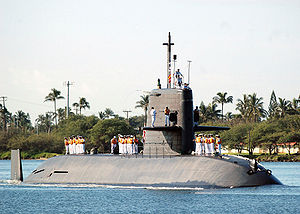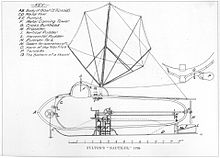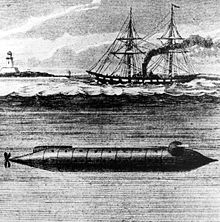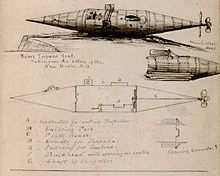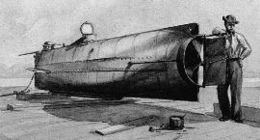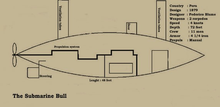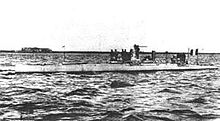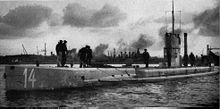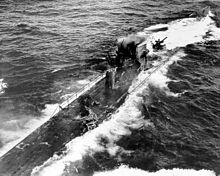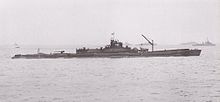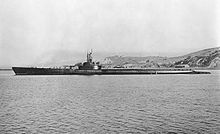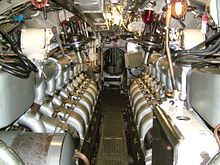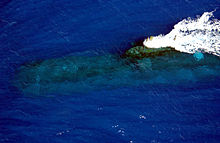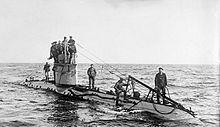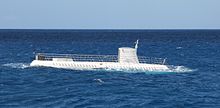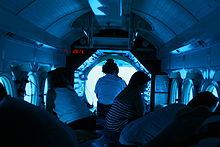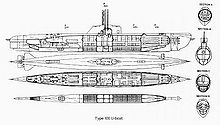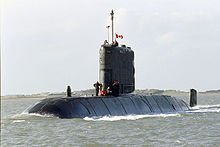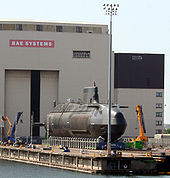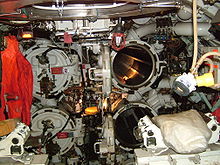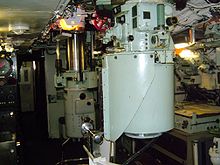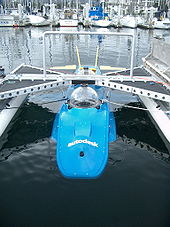- Submarine
-
For other uses, see Submarine (disambiguation).
A submarine is a watercraft capable of independent operation below the surface of the water. It differs from a submersible, which has more limited underwater capability. The term submarine most commonly refers to a large crewed autonomous vessel; however, historically or colloquially, submarine can also refer to medium sized or smaller vessels (midget submarines, wet subs), remotely operated vehicles or robots.
The word submarine was originally an adjective meaning "under the sea"; consequently other uses such as "submarine engineering" or "submarine cable" may not actually refer at all to the vessel. Submarine was in fact shortened from the proper term, "submarine boat", and is often further shortened to "sub" when the word is employed informally. Submarines should always be referred to as "boats" rather than as "ships", regardless of their size. The English term U-boat for a German submarine comes from the German word for submarine, U-Boot, itself an abbreviation for Unterseeboot ("undersea boat").
Although experimental submarines had been built before, submarine design took off during the 19th century, and they were adopted by several different navies. Submarines were first widely used during World War I (1914–1918) and now feature in many large navies. Military usage includes attacking enemy surface ships or submarines, aircraft carrier protection, blockade running, ballistic missile submarines as part of a nuclear strike force, reconnaissance, conventional land attack (for example using a cruise missile), and covert insertion of special forces. Civilian uses for submarines include marine science, salvage, exploration and facility inspection/maintenance. Submarines can also be modified to perform more specialized functions such as search-and-rescue missions or undersea cable repair. Submarines are also used in tourism, and for undersea archaeology.
Most large submarines comprise a cylindrical body with hemispherical (and/or conical) ends and a vertical structure, usually located amidships, which houses communications and sensing devices as well as periscopes. In modern submarines this structure is the "sail" in American usage, and "fin" in European usage. A "conning tower" was a feature of earlier designs: a separate pressure hull above the main body of the boat that allowed the use of shorter periscopes. There is a propeller (or pump jet) at the rear and various hydrodynamic control fins as well as ballast tanks. Smaller, deep diving and specialty submarines may deviate significantly from this traditional layout.
Submarines have one of the largest ranges of capabilities in any vessel, ranging from small autonomous examples to one- or two-person vessels operating for a few hours, to vessels which can remain submerged for 6 months such as the Russian Typhoon class - the biggest submarines ever built and in use. Submarines can work at greater depths than are survivable or practical for human divers. Modern deep diving submarines are derived from the bathyscaphe, which in turn was an evolution of the diving bell.
History of submarines
Main article: History of submarinesEarly history of submarines and the first submersibles
 The Drebbel, the first navigable submarine
The Drebbel, the first navigable submarine
The first submersible with reliable information on its construction was built in 1620 by Cornelius Jacobszoon Drebbel, a Dutchman in the service of James I of England. It was created to the standards of the design outlined by English mathematician William Bourne. It was propelled by means of oars. The precise nature of the submarine type is a matter of some controversy; some claim that it was merely a bell towed by a boat. Two improved types were tested in the Thames between 1620 and 1624. In 2002 a two-person version of Bourne's design was built for the BBC TV programme Building the Impossible by Mark Edwards, and successfully rowed under water at Dorney Lake, Eton.
Though the first submersible vehicles were tools for exploring under water, it did not take long for inventors to recognize their military potential. The strategic advantages of submarines were set out by Bishop John Wilkins of Chester, England, in Mathematicall Magick in 1648:
- Tis private: a man may thus go to any coast in the world invisibly, without discovery or prevented in his journey.
- Tis safe, from the uncertainty of Tides, and the violence of Tempests, which do never move the sea above five or six paces deep. From Pirates and Robbers which do so infest other voyages; from ice and great frost, which do so much endanger the passages towards the Poles.
- It may be of great advantages against a Navy of enemies, who by this may be undermined in the water and blown up.
- It may be of special use for the relief of any place besieged by water, to convey unto them invisible supplies; and so likewise for the surprisal of any place that is accessible by water.
- It may be of unspeakable benefit for submarine experiments.
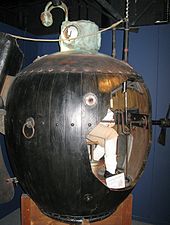

A replica of the Turtle on display at the Royal Navy Submarine Museum, Gosport First military submarines
The first military submarine was Turtle (1775), a hand-powered acorn-shaped device designed by the American David Bushnell to accommodate a single person. It was the first verified submarine capable of independent underwater operation and movement, and the first to use screws for propulsion. During the American Revolutionary War, Turtle (operated by Sgt. Ezra Lee, Continental Army) tried and failed to sink the British warship HMS Eagle, flagship of the blockaders in New York harbor on September 7, 1776.[1]
In 1800, France built a human-powered submarine designed by American Robert Fulton, the Nautilus. The French eventually gave up on the experiment in 1804, as did the British when they later considered Fulton's submarine design.
During the War of 1812, in 1814, Silas Halsey lost his life while using a submarine in an unsuccessful attack on a British warship stationed in New London harbor.
The Submarino Hipopótamo was the first submarine in South America built and tested in Ecuador on September 18, 1837. It was designed by Jose Rodriguez Lavandera, who successfully crossed the Guayas River in Guayaquil accompanied by Jose Quevedo. Rodriguez Lavandera had enrolled in the Ecuadorian Navy in 1823, becoming a Lieutenant by 1830. The Hipopotamo crossed the Guayas on two more occasions, but it was then abandoned because of lack of funding and interest from the government. Today, few engravings[2] and a scale model of the original design is preserved by the Maritime Museum of the Ecuadorian Navy.[3]
In 1851, a Bavarian artillery corporal, Wilhelm Bauer, took a submarine designed by him called the Brandtaucher (incendiary-diver), which sank on its first test dive in Kiel Harbour—but its three crewmen managed to escape, after flooding the vessel, which allowed the inside pressure to equalize.[4] This submarine was built by August Howaldt and powered by a treadwheel. The submarine was re-discovered during a dredging operation 1887, and was raised sixteen years later. The vessel is on display in a museum in Dresden.
The submarine Flach was commissioned in 1865 by the Chilean government during the war of Chile and Peru against Spain (1864–1866). It was built by the German engineer Karl Flach. The submarine sank during tests in Valparaiso bay on May 3, 1866, with the entire eleven-man crew.
Submarines in the American Civil War
During the American Civil War both sides successfully built working submarines. The Confederate States of America submarines were all designed to attack the Union blockade of Southern ports. Two operational unnamed Confederate submarines were spotted during the latter half of 1861, one in the James River in Virginia and another in New Orleans.[5] The United States Navy was first interested in submarines as a way to clear obstacles. Interest in attack submarines began at least by May 1861, when French engineer Brutus de Villeroi tested an early submarine design in Philadelphia harbor in what may have been a effort to attract the Navy's attention. Most Confederate submarines were built under the auspices of the Confederate Secret Service rather than the Confederate Navy, with only three being well known and documented. Others, both Confederate and Union, are known to have existed but their names and designs have escaped the historical record. In all, evidence indicates that a combined total of over twenty operational submarines were built by both sides during the conflict.[5]
First launched on May 1, 1862, the Villeroi-designed Alligator was the first U.S. Navy submarine. It was also the first to feature compressed air for an air supply and an air filtration system. Initially propelled by sixteen hand-powered paddles protruding from the sides, it was converted after six months to a screw propeller powered by a hand crank. At 47 feet (14.3 m) long and about 4 feet (1.2 m) in diameter, the Alligator was the largest of the documented American Civil War submarines. It was lost in a storm off Cape Hatteras on April 1, 1863 while under tow to its first combat deployment at Charleston.[6][5]
The first documented Confederate submarine was the New Orleans-built Pioneer. It was 30 feet (9 m) long. This submarine sank a target schooner using a towed mine during tests on Lake Pontchartrain in February 1862. It was never used in combat, having been scuttled by Confederate forces before New Orleans was captured by the Union in April 1862.[5] The Bayou St. John Confederate Submarine is another Louisiana-built submarine that is contemporaneous with the Pioneer, although no history is known. It is now on display at the Louisiana State Museum.
The second documented Confederate submarine was the American Diver, also known as the Pioneer II, built in Mobile, Alabama. It was initially designed to be propelled by an electric motor but this proved to be too weak. A steam engine was installed next, but also proved to be insufficient. Finally, a hand-cranked propeller was installed. The Diver was 36 feet (11 m) long with a 3-foot (0.91 m) beam. It was lost during a storm while under tow during trials in Mobile Bay in late February 1863.[7][5]
The third documented Confederate submarine was H. L. Hunley, named for one of its financiers, Horace Lawson Hunley. Also built in Mobile, she was launched in July 1863. She was 39.5 feet (12.0 m) long with a 3.83-foot (1.17 m) beam. Hunley was designed to be propelled by a hand-crank from the beginning and could accommodate eight men to turn the hand-crank, as opposed to four men for Diver,[7] and was armed with a spar torpedo. The submarine had to approach an enemy vessel, attach the explosive with a barb, move away, and then detonate it. Hunley proved to be hazardous to operate, and had no air supply other than what was contained in the hull. On three occasions, she sank. On August 29, 1863, five out of the nine crew members drowned during a trial run.[8] The second incident occurred on October 15, 1863, when all eight people on board, including Hunley, drowned during a diving exercise.[9] Then, on February 17, 1864, the salvaged and renovated vessel sank USS Housatonic off Charleston Harbor. Soon after signaling success, the submarine sank due to unknown cause; again the entire eight-man crew drowned.[10] Submarines did not have a major impact on the outcome of the war, but did portend their future importance to, and increased interest in their use in, naval warfare. The location of Hunley was unknown until 1995,[11] and she was raised in 2000. The sinking of Housatonic by Hunley was the first successful submarine attack on a warship.[12]
Mechanically powered submarines, late 19th Century
The first submarine not relying on human power for propulsion was the French Plongeur (Diver), launched in 1863, and using compressed air at 180 psi (1241 kPa).[13]
The first combustion-powered submarine was Ictineo II, designed in Catalonia, Spain by Narcís Monturiol. Originally launched in 1864 as human-powered, propelled by 16,[13] it was converted to peroxide propulsion and steam in 1867. The 14 m (46 ft)-long craft was designed for a crew of two, could dive to 30 m (98 ft), and demonstrated dives of two hours. On the surface it ran on a steam engine, but underwater such an engine would quickly consume the submarine's oxygen, so Monturiol invented an air-independent propulsion system. While the air-independent power system drove the screw, the chemical process driving it also released oxygen into the hull for the crew and an auxiliary steam engine. Monturiol's fully functional, double hulled vessels also solved pressure and buoyancy control problems that had bedeviled earlier designs.
In 1870, the French writer Jules Verne, inspired by the recent efforts of Monturiol and of his own navy, published the science fiction classic 20,000 Leagues under the Sea, which concerns the adventures of a maverick inventor of the Nautilus, a submarine more advanced than any at the time. An international success, the story encouraged inventors around the world to work towards making such a vehicle a reality.
In 1879, the Peruvian government, during the War of the Pacific, commissioned and built the fully operational submarine Toro Submarino. It never saw military action before being scuttled by the Peruvians after their defeat in the war to prevent its capture by the Chileans.
The first submarine to be mass-produced was human-powered. It was the submarine of the Polish inventor Stefan Drzewiecki—50 units were built in 1881 for the Russian government. In 1884 the same inventor built an electric-powered submarine.
Discussions between the English clergyman and inventor George Garrett and the industrially and commercially adept Swede Thorsten Nordenfelt led to a series of steam-powered submarines. The first was the Nordenfelt I, a 56 tonne, 19.5 metre (64 ft) vessel similar to Garret's ill-fated Resurgam (1879), with a range of 240 kilometres (150 mi, 130 nm), armed with a single torpedo, in 1885. Like Resurgam, Nordenfelt I operated on the surface by steam, then shut down its engine to dive. While submerged the submarine released pressure generated when the engine was running on the surface to provide propulsion for some distance underwater. Greece, fearful of the return of the Ottomans, purchased it. Nordenfelt then built Nordenfelt II (Abdülhamid) in 1886 and Nordenfelt III (Abdülmecid) in 1887, a pair of 30 metre (100 ft) submarines with twin torpedo tubes, for the Ottoman navy. Abdülhamid became the first submarine in history to fire a torpedo submerged.[14] Nordenfelt's efforts culminated in 1887 with Nordenfelt IV which had twin motors and twin torpedoes. It was sold to the Russians, but proved unstable, ran aground, and was scrapped.
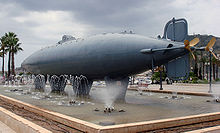 Peral submarine hull, Cartagena
Peral submarine hull, Cartagena
Two submarines, both launched in September 1888, marked the maturing of naval submarine technology.
One was the Peral Submarine, launched by the Spanish Navy. It had two torpedoes, new air systems, hull shape, propeller, and cruciform external controls anticipating much later designs. Peral was the first all-electrical powered submarine.[15] After two years of trials the project was scrapped by naval officialdom that cited concerns over the short range permitted by its batteries.
The other was the Gymnote, launched by the French Navy. Gymnote was also an electrically powered and fully functional military submarine. It completed over 2,000 successful dives using a 204-cell battery.[16] Although she was scrapped for her limited range her side hydroplanes became the standard for future submarine designs.
Many more designs were built at this time by various inventors, but submarines were not put into service by navies until 1900.
End of the 19th century to the Russo-Japanese War
The turn of the 20th century marked a pivotal time in the development of submarines, with a number of important technologies making their debut, as well as the widespread adoption and fielding of submarines by a number of nations. Diesel electric propulsion would become the dominant power system and equipment such as the periscope would become standardized. Large numbers of experiments were done by countries on effective tactics and weapons for submarines, all of which would culminate in them making a large impact on the coming World War I.
In 1896, the Irish-American inventor John Philip Holland designed submarines that, for the first time, made use of internal combustion engines on the surface and electric battery power submerged. Fenian Ram, in 1881, was world's first successful submarine.[citation needed] Holland VI was launched on May 17, 1897 at Navy Lt. Lewis Nixon's Crescent Shipyard of Elizabeth, New Jersey. On April 11, 1900 the United States Navy purchased the revolutionary Holland VI and renamed it USS Holland (SS-1), America's first commissioned submarine. (John P. Holland's company, the Holland Torpedo Boat Company/Electric Boat Company became General Dynamics' Cold War progeny and is the builder of technologically advanced submarines today).
Commissioned in June 1900, the French steam and electric Narval introduced the classic double-hull design, with a pressure hull inside the outer shell. These 200-ton ships had a range of over 100 miles (160 km) underwater. The French submarine Aigrette in 1904 further improved the concept by using a diesel rather than a gasoline engine for surface power. Large numbers of these submarines were built, with seventy-six completed before 1914.
Submarines during the Russo-Japanese War
The first mechanically powered series of submarines to be put into service by navies, which included Great Britain, Japan, Russia, and the United States, were the Holland submersibles built by Irish designer John Philip Holland in 1900.[17] Several of each of them were retained in both the Imperial Russian and Japanese Navies during the Russo-Japanese War in 1904-1905.
The Imperial Japanese Navy (IJN) started their submarine service with five Holland Type VII submarines purchased from the Electric Boat Company in 1904. The five vessels were delivered in sections, arriving in Japan on 14 June 1904. After re-assembly, the five Hollands were ready for combat operations in August 1905,[18] but the Russo-Japanese War was nearing its end by that date, and no IJN submarines would see action in that war.
The first submarines built in Japan were constructed by Kawasaki beginning in 1904. The Kaigun Holland Type #6 and #7 were each launched on 28 September but a year apart, in 1905 and 1906 respectively. Both submarines were modified versions of the original imported Hollands. However, while the original vessels had each displaced over a 100 tons submerged, and were approximately 67' long and 11' wide; the Kawasaki boats displaced only 63/95 tons submerged, and measured 73'/84' by 7' respectively for the number 6 & 7 submarines. The Kawasaki machines had increased horse-power by 1/2, and reduced fuel consumption by 1/4, but could only launch one 18" torpedo and carried 14 men, while the Hollands could fire two 18" torpedoes and operate with only 13 crewmen.[18] The Kaigun Holland #6 submarine has been preserved as a memorial at Kure, Japan.[18]
The Imperial Russian Navy (IRN) preferred the German constructed submersibles built by the Germaniawerft shipyards out of Kiel. In 1903 Germany successfully completed its first fully functional engine-powered submarine, the Forelle (Trout).[19] This vessel was sold to Russia in 1904 and shipped via the Trans-Siberian Railway to the combat zone during the Russo-Japanese War.[20] In 1901 two IRN Lieutenants, Kolbasieff and Kuteinoff designed and built the electric submarine Piotr Koschka which was operated by bicycle pedals, but no other versions were built. During the final weeks of the Port Arthur siege in 1904, the IRN attempted to place the Piotr Koschka into operation, her bicycle pedals having been replaced by an automobile engine. But the attempt to deploy the submarine into the Port Arthur battle was unsuccessful.[21]
A prototype version of the Plunger-class or A-class submarines, the Fulton, was developed at Nixon's Crescent Shipyard for the United States Navy before the construction of the A-class submarines there in 1901. A naval architect and shipbuilder from the United Kingdom, Arthur Leopold Busch, superintended the development of these first submarines for Holland's company. However the Fulton was never purchased by the U.S. Navy and was eventually sold to the Imperial Russian Navy during the Russo-Japanese War of 1904-1905. Two other A-class vessels were built on the West Coast of (USA) at Mare Island Naval Shipyard/Union Iron Works circa 1901. In 1902, Holland received a patent for his persistent pursuit to perfect the underwater naval craft. By this time, Holland was no longer in control of the day-to-day operations at Electric Boat, as others were now at the helm of the company he once founded. The acumen of business were now in control of these operations as Holland was forced to step down. His resignation from the company was to be effective as of April 1904.[22]
Due to the blockade at Port Arthur, Russia sent the remainder of their submarines to Vladivostok, where by 1 January 1905 there were seven boats, enough to create the world's first "operational submarine fleet." The new submarine fleet sent out its first patrol on 14 February, usually lasting for about 24 hours. The first confrontation with Japanese warships occurred on 29 April 1905 when the IRN sub Som was fired upon by IJN torpedo boats, but then withdrew.[23]
In 1904, the Imperial Russian Navy ordered several more submersibles from the Kiel shipyard, submarines from the Karp class. One sample of which was modified and improved, and commissioned into the Imperial German Navy in 1906 as its first U-Boat, the U-1.[20] U-1 was retired from service in 1919, and is currently preserved and on display in the Deutsches Museum in Munich.[24]
Submarines during World War I
Military submarines first made a significant impact in World War I. Forces such as the U-boats of Germany saw action in the First Battle of the Atlantic, and were responsible for the sinking of Lusitania, which was sunk as a result of unrestricted submarine warfare and is often cited among the reasons for the entry of the United States into the war.[25]
In August 1914, a flotilla of ten U-boats sailed from their base in Heligoland to attack Royal Navy warships in the North Sea in the first submarine war patrol in history.[26] Their aim was to sink capital ships of the British Grand Fleet, and so reduce the Grand Fleet's numerical superiority over the German High Seas Fleet. With much depending more on luck than strategy, the first sortie was not a success. Only one attack was carried out, when U-15 fired a torpedo (which missed) at HMS Monarch, while two of the ten U-boats were lost. The U-9 had better luck. On 22 September 1914 while patrolling the Broad Fourteens, a region of the southern North Sea, U-9 found a squadron of three obsolescent British Cressy-class armoured cruisers (HMS Aboukir, HMS Hogue, and HMS Cressy), which were assigned to prevent German surface vessels from entering the eastern end of the English Channel. She fired all six of her torpedoes, reloading while submerged, and sank all three in less than an hour.
The U-boats' ability to function as practical war machines relied on new tactics, their numbers, and submarine technologies such as combination diesel-electric power system developed in the preceding years. More submersibles than true submarines, U-boats operated primarily on the surface using regular engines, submerging occasionally to attack under battery power. They were roughly triangular in cross-section, with a distinct keel to control rolling while surfaced, and a distinct bow. During World War I more than 5,000 Allied ships were sunk by U-boats.[27]
Interwar developments
Various new submarine designs were developed during the interwar years. Among the most notable ones were submarine aircraft carriers, equipped with a waterproof hangar and steam catapult to launch and recover one or more small seaplanes. The submarine and its plane could then act as a reconnaissance unit ahead of the fleet, an essential role at a time when radar still did not exist. The first example was the British HMS M2, followed by the French Surcouf, and numerous aircraft-carrying submarines in the Imperial Japanese Navy.
Submarines during World War II
Germany
Main article: U-boatGermany had the largest submarine fleet during World War II. Due to the Treaty of Versailles limiting the surface navy, the rebuilding of the German surface forces had only begun in earnest a year before the outbreak of World War II. Expecting to be able to defeat the Royal Navy through underwater warfare, the German High Command pursued commerce raiding and immediately stopped all construction on capital surface ships save the nearly completed Bismarck-class battleships and two cruisers, switching its resources to submarines, which could be built more quickly. Though it took most of 1940 to expand the production facilities and get the mass production started, more than a thousand submarines were built by the end of the war.
During World War II, Germany utilized submarines to devastating effect in the Second Battle of the Atlantic, attempting to cut Britain's supply routes by sinking more merchant ships than Britain could replace. (Shipping was vital to supply Britain's population with food, industry with raw material, and armed forces with fuel and armaments.) While U-boats destroyed a significant number of ships, the strategy ultimately failed. Although the U-boats had been updated in the interwar years, the major innovation was improved communications, encrypted using the famous Enigma cipher machine. This allowed for mass-attack tactics (Rudeltaktik, commonly known as "wolfpack"), but was also ultimately the U-boats' downfall.
After putting to sea, U-boats operated mostly on their own, trying to find convoys in areas assigned to them by the High Command. If a convoy was found, the submarine did not attack immediately, but shadowed to guide other submarines in the area. These then attacked more or less simultaneously, preferably at night while surfaced, which offered a speed advantage over the escorting corvettes and denied the Allies the ability to use ASDIC, which was unable to detect surfaced submarines.
From September 1939 to the beginning of 1943,[citation needed] the Ubootwaffe ("U-boat force") scored unprecedented success with these tactics, but were too few to have any decisive success. By the spring of 1943, German U-boat construction was at full capacity, but this was more than nullified by increased numbers of convoy escorts and aircraft, as well as technical advances like radar and sonar. High Frequency Direction Finding (HF/DF, known as Huff-Duff) and Ultra allowed the Allies to route convoys around wolfpacks when they detected radio transmissions from trailing boats. The results were devastating: from March to July of that year, over 130 U-boats were lost, 41 in May alone. Concurrent Allied losses dropped dramatically, from 750,000 tons in March to only 188,000 in July. Although the Second battle of the Atlantic would continue to the last day of the war, the U-boat arm was unable to stem the tide of personnel and supplies, paving the way for Operation Torch, Operation Husky, and ultimately, D-Day. Winston Churchill wrote the U-boat "peril" was the only thing to ever give him cause to doubt eventual Allied victory.
By the end of the war, almost 3,000 Allied ships (175 warships, 2,825 merchantmen) were sunk by U-boats.[28] Of the 40,000 men in the U-boat service, 28,000 (70%) lost their lives.
Japan
Main article: Imperial Japanese Navy submarinesDuring World War II, the IJN operated the most varied fleet of submarines of any navy; including Kaiten crewed torpedoes, midget submarines (Ko-hyoteki and Kairyu), medium-range submarines, purpose-built supply submarines and long-range fleet submarines. They also had submarines with the highest submerged speeds during World War II (I-201-class submarines) and submarines that could carry multiple aircraft (I-400-class submarine). They were also equipped with one of the most advanced torpedoes of the conflict, the oxygen-propelled Type 95.
Nevertheless, despite their technical prowess, Japan had chosen to utilize its submarines for fleet warfare, and consequently were relatively unsuccessful, as warships were fast, maneuverable and well-defended compared to merchant ships. In 1942, a Japanese submarine sank one aircraft carrier, damaged one battleship, and damaged one destroyer (which sank later) from one torpedo salvo; and during the Battle of Midway were able to deliver the coup de grace to another fleet aircraft carrier, again, sinking another destroyer, for another multiple score from one salvo. But with the lack of fuel oil and air supremacy, Imperial submarines were not able to sustain those kind of results afterwards. By the end of the war, submarines were instead often relegated to transport supplies to island garrisons.
United States
After the attack on Pearl Harbor, many of the U.S. Navy's front-line Pacific Fleet surface ships were destroyed or severely damaged. The submarines survived the attack and carried the war to the enemy. Lacking support vessels, the submarines were asked to independently hunt and destroy Japanese ships and submarines. They did so very effectively and without the assistance of other supporting ships.
During World War II the submarine force was the most effective anti-ship and anti-submarine weapon in the entire American arsenal. Submarines, though only about 2 percent of the U.S. Navy, destroyed over 30 percent of the Japanese Navy, including 8 aircraft carriers, 1 battleship and 11 cruisers. U.S. submarines also destroyed over 60 percent of the Japanese merchant fleet, crippling Japan's ability to supply its military forces and industrial war effort. Allied submarines in the Pacific War destroyed more Japanese shipping, than all other weapons combined. This feat was considerably aided by the Imperial Japanese Navy's failure to provide adequate escort forces for the nation's merchant fleet.
Of note, whereas Japan had the finest submarine torpedoes of the war, the U.S. Navy had the worst: for example, the U.S. Mark 14 torpedo typically ran ten feet too deep and was tipped with a Mk VI exploder, with both magnetic influence and contact features, neither reliable. The faulty depth control mechanism of the Mark 14 was corrected in August 1942, but field trials for the exploders were not ordered until mid-1943, when tests in Hawaii and Australia confirmed the flaws. In addition, the Mark 14 sometimes suffered circular runs, which sank at least one U.S. submarine, Tullibee.[29] Fully operational Mark 14 torpedoes were not put into service until September 1943. The Mark 15 torpedo used by U.S. surface combatants had the same Mk VI exploder and was not fixed until late 1943. One attempt to correct the problems resulted in a wakeless, electric torpedo (the Mark 18) being placed in submarine service; Tang was lost to a circular run by one of these torpedoes.[30] Given the prevalence of circular runs, there were probably other losses among boats which simply disappeared.[31]
During World War II, 314 submarines served in the United States Navy, of which nearly 260 were deployed to the Pacific.[32] On December 7, 1941, 111 boats were in commission; 203 submarines from the Gato, Balao, and Tench classes were commissioned during the war. During the war, 52 US submarines were lost to all causes, with 48 directly due to hostilities;[33] 3,505[32][34] sailors were lost, the highest percentage killed in action of any US service arm in World War II. U.S. submarines sank 1,560 enemy vessels,[32] a total tonnage of 5.3 million tons (55% of the total sunk),[35] including 8 aircraft carriers, a battleship, three heavy cruisers, and over 200 other warships.[35] In addition, the Japanese merchant marine lost 16,200 sailors killed and 53,400 wounded, of some 122,000 at the start of the war, due to submarines.[35]
United Kingdom
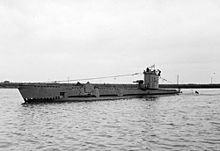 The British submarine HMS Venturer.
The British submarine HMS Venturer.
The Royal Navy Submarine Service was primarily used to enforce the classic British blockade role. It therefore chiefly operated in inshore waters[citation needed] and tended to only surface by night.
Its major operating areas were around Norway, the Mediterranean (against the Axis supply routes to North Africa), and in the Far East. Royal Navy submarines operating out of Trincomalee and Australia were a constant threat to Japanese shipping passing through the Malacca Straits.[citation needed]
In the war British submarines sank 2 million tons of enemy shipping and 57 major warships, the latter including 35 submarines. Among these is the only documented instance of a submarine sinking another submarine while both were submerged. This occurred when HMS Venturer engaged the U864; the Venturer crew manually computed a successful firing solution against a three-dimensionally manoeveuring target using techniques which became the basis of modern torpedo computer targeting systems. Seventy-four British submarines were lost,[36] the majority, 42, in the Mediterranean.
Snorkel
Diesel-electric submarines need air to run their diesel engines, and so carried very large batteries for submerged operation. The need to recharge the batteries from the diesel engines limited the endurance of the submarine while submerged and required it to surface regularly for extended periods, during which it was especially vulnerable to detection and attack. The snorkel, a pre-war Dutch invention, was used to allow German submarines to run their diesel engines whilst running just under the surface, drawing air through a tube from the surface.
The German Navy also experimented with engines that would use hydrogen peroxide to allow diesel fuel to be used while submerged, but technical difficulties were great. The Allies experimented with a variety of detection systems, including chemical sensors to "smell" the exhaust of submarines.
Cold-war diesel-electric submarines, such as the Oberon class, used batteries to power their electric motors in order to run silently. They recharged the batteries using the diesel engines without ever surfacing.[citation needed]
Modern military submarines
The first launch of a cruise missile (SSM-N-8 Regulus) from a submarine occurred in July 1953 from the deck of USS Tunny, a World War II fleet boat modified to carry this missile with a nuclear warhead. Tunny and her sister boat Barbero were the United States's first nuclear deterrent patrol submarines. They were joined in 1958 by two purpose built Regulus submarines, Grayback, Growler, and, later, by the nuclear powered Halibut.
In the 1950s, nuclear power partially replaced diesel-electric propulsion. Equipment was also developed to extract oxygen from sea water. These two innovations gave submarines the ability to remain submerged for weeks or months, and enabled previously impossible voyages such as USS Nautilus' crossing of the North pole beneath the Arctic ice cap in 1958[37] and the USS Triton's submerged circumnavigation of the world in 1960.[38] Most of the naval submarines built since that time in the United States and the Soviet Union/Russia have been powered by nuclear reactors. The limiting factors in submerged endurance for these vessels are food supply and crew morale in the space-limited submarine.
In 1959–1960, the first ballistic missile submarines were put into service by both the United States (George Washington class) and the Soviet Union (Hotel class) as part of the Cold War nuclear deterrent strategy.
While the greater endurance and performance from nuclear reactors makes nuclear submarines better for long-distance missions or the protection of a carrier battle group, their reactor cooling pumps have traditionally made them noisier, and thus easier to detect, than conventional diesel-electric submarines. Diesel-electrics have continued to be produced by both nuclear and non-nuclear powers as they lack this limitation, except when required to run the diesel engine to recharge the ship’s battery. Recent technological advances in sound damping, noise isolation, and cancellation have made nuclear subs quieter and substantially eroded this disadvantage. Though far less capable regarding speed and weapons payload, conventional submarines are also cheaper to build. The introduction of air-independent propulsion boats, conventional diesel-electric submarines with some kind of auxiliary air-independent electricity generator, have led to increased sales of such types of submarines.
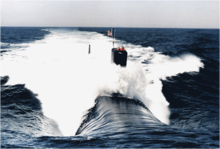 Nuclear powered Los Angeles-class submarines form the backbone of the United States submarine fleet.
Nuclear powered Los Angeles-class submarines form the backbone of the United States submarine fleet.
During the Cold War, the United States and the Soviet Union maintained large submarine fleets that engaged in cat-and-mouse games. The Soviet Union suffered the loss of at least four submarines during this period: K-129 was lost in 1968 (which the CIA attempted to retrieve from the ocean floor with the Howard Hughes -designed ship Glomar Explorer), K-8 in 1970, K-219 in 1986, and Komsomolets in 1989 (which held a depth record among military submarines—1000 m). Many other Soviet subs, such as K-19 (the first Soviet nuclear submarine, and the first Soviet sub to reach the North Pole) were badly damaged by fire or radiation leaks. The US lost two nuclear submarines during this time: USS Thresher due to equipment failure during a test dive while at its operational limit, and USS Scorpion due to unknown causes.
During the Indo-Pakistani War of 1971, the Pakistan Navy's Hangor sank the Indian frigate INS Khukri. This was the first kill by a submarine since World War II, and the only one until the United Kingdom employed nuclear-powered submarines against Argentina in 1982 during the Falklands War. The Argentine cruiser General Belgrano was sunk by HMS Conqueror (the first sinking by a nuclear-powered submarine in war). The PNS Ghazi, a Tench-class submarine on loan to Pakistan from the US, was sunk in the Indo-Pakistani War. It was the first submarine casualty since World War II during war time.
More recently, Russia has had three high profile submarine accidents. The Kursk went down with all hands in 2000; the K-159 sank while being towed to a scrapyard in 2003, with nine lives lost; and the Nerpa had an accident with the fire-extinguishing system resulting in twenty deaths in late 2008.
India launched its first locally built nuclear-powered submarine, the INS Arihant, on July 26, 2009.[39]
A North Korean submarine's torpedo allegedly sank the South Korean navy ship ROKS Cheonan on 26 March 2010.[40]
Polar operations
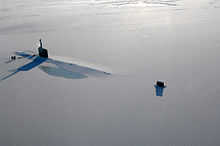 US Navy attack submarine USS Annapolis rests in the Arctic Ocean after surfacing through three feet of ice during Ice Exercise 2009 on March 21, 2009.
US Navy attack submarine USS Annapolis rests in the Arctic Ocean after surfacing through three feet of ice during Ice Exercise 2009 on March 21, 2009.
- 1903 – Simon Lake submarine Protector surfaced through ice off Newport, Rhode Island.[41]
- 1930 – USS O-12 operated under ice near Spitsbergen.[41]
- 1937 – Soviet submarine Krasnogvardeyets operated under ice in the Denmark Strait.[41]
- 1941–45 – German U-boats operated under ice from the Barents Sea to the Laptev Sea.[41]
- 1946 – USS Atule used upward-beamed fathometer in Operation Nanook in the Davis Strait.[41]
- 1946–47 – USS Sennet used under-ice SONAR in Operation High Jump in the Antarctic.[41]
- 1947 – USS Boarfish used upward-beamed echo sounder under pack ice in the Chukchi Sea.[41]
- 1948 – USS Carp developed techniques for making vertical ascents and descents through polynyas in the Chukchi Sea.[41]
- 1952 – USS Redfish used an expanded upward-beamed sounder array in the Beaufort Sea.[41]
- 1957 – USS Nautilus reached 87 degrees north near Spitsbergen.[41]
- 3 August 1958 – Nautilus used an inertial navigation system to reach the North Pole.[41]
- 17 March 1959 – USS Skate surfaced through the ice at the north pole.[41]
- 1960 – USS Sargo transited 900 miles (1,400 km) under ice over the shallow (125 to 180 feet/38 to 55 metres deep) Bering-Chukchi shelf.[41]
- 1960 – USS Seadragon transited the Northwest Passage under ice.[41]
- 1962 – Soviet November-class submarine Leninskiy Komsomol reached the north pole.[41]
- 1970 – USS Queenfish carried out an extensive undersea mapping survey of the Siberian continental shelf.[42]
- 1971 – HMS Dreadnought reached the North Pole.[41]
- 6 May 1986 – USS Ray, USS Archerfish and USS Hawkbill meet and surface together at the Geographic North Pole. First multi-submarine surfacing at the Pole.[citation needed]
- 19 May 1987 – HMS Superb joined USS Billfish and USS Sea Devil at the North Pole. The first time British and Americans met at the North Pole.[citation needed]
- March 2007 – USS Alexandria participated in the Joint U.S. Navy/Royal Navy Ice Exercise 2007 (ICEX-2007) in the Arctic Ocean with the Trafalgar-class submarine HMS Tireless.[citation needed]
- March 2009 – USS Annapolis took part in Ice Exercise 2009 to test submarine operability and war-fighting capability in Arctic conditions.[citation needed]
Military usage
Before and during World War II, the primary role of the submarine was anti-surface ship warfare. Submarines would attack either on the surface or submerged, using torpedoes or (on the surface) deck guns. They were particularly effective in sinking Allied transatlantic shipping in both World Wars, and in disrupting Japanese supply routes and naval operations in the Pacific in World War II.
Mine-laying submarines were developed in the early part of the 20th century. The facility was used in both World Wars. Submarines were also used for inserting and removing covert agents and military forces, for intelligence gathering, and to rescue aircrew during air attacks on islands, where the airmen would be told of safe places to crash-land so the submarines could rescue them. Submarines could carry cargo through hostile waters or act as supply vessels for other submarines.
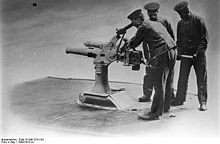 Retractable 7.5 cm submarine gun produced by the Krupp company circa 1900
Retractable 7.5 cm submarine gun produced by the Krupp company circa 1900
Submarines could usually locate and attack other submarines only on the surface, although HMS Venturer managed to sink U-864 with a four torpedo spread while both were submerged. The British developed a specialized anti-submarine submarine in WWI, the R class. After WWII, with the development of the homing torpedo, better sonar systems, and nuclear propulsion, submarines also became able to hunt each other effectively.
The development of submarine-launched ballistic missile and submarine-launched cruise missiles gave submarines a substantial and long-ranged ability to attack both land and sea targets with a variety of weapons ranging from cluster bombs to nuclear weapons.
The primary defense of a submarine lies in its ability to remain concealed in the depths of the ocean. Early submarines could be detected by the sound they made. Water is an excellent conductor of sound (much better than air), and submarines can detect and track comparatively noisy surface ships from long distances. Modern submarines are built with an emphasis on stealth. Advanced propeller designs, extensive sound-reducing insulation, and special machinery allow a submarine to be as quiet as ambient ocean noise, making them difficult to detect. It takes specialized technology to find and attack modern submarines.
Active sonar uses the reflection of sound emitted from the search equipment to detect submarines. It has been used since WWII by surface ships, submarines and aircraft (via dropped buoys and helicopter "dipping" arrays), but it gives away the position of the emitter and is susceptible to counter-measures.
A concealed military submarine is a real threat, and because of its stealth, can force an enemy navy to waste resources searching large areas of ocean and protecting ships against attack. This advantage was vividly demonstrated in the 1982 Falklands War when the British nuclear-powered submarine HMS Conqueror sank the Argentine cruiser General Belgrano. After the sinking the Argentine Navy recognised that they had no effective defense against submarine attack, and the Argentine surface fleet withdrew to port for the remainder of the war, though an Argentine submarine remained at sea.
Civil usage
Although the majority of the world's submarines are military, there are some civil submarines. They have a variety of uses, including tourism, exploration, oil and gas platform inspections and pipeline surveys. The first tourist submarine was launched in 1985, and by 1997 there were 45 of them operating around the world.[43]
Submarines with a crush depth in the range of 400–500 feet (120–150 m) are operated in several areas worldwide, typically with bottom depths around 100 to 120 feet (30 to 37 m), with a carrying capacity of 50 to 100 passengers. In a typical operation (for example, Atlantis submarines), a surface vessel carries passengers to an offshore operating area, where passengers are exchanged with those of the submarine. The submarine then visits underwater points of interests, typically either natural or artificial reef structures. To surface safely without danger of collision the location of the submarine is marked with an air release and movement to the surface is coordinated by an observer in a support craft. A recent development is the deployment of so called narco submarines by South American drug smugglers, in order to evade detection.[44] Although they occasionally deploy true submarines, most are self-propelled semi-submersibles, where a portion of the craft remains above water at all times. On September 2011, Colombian authority have seized 16-meter long submersible and could hold a crew of 5 with cost about $2 million. The vessel was belonging to FARC rebels and had the capacity to carry at least 7 tonnes of drugs.[45]
Technology
Submersion and trimming
All surface ships, as well as surfaced submarines, are in a positively buoyant condition, weighing less than the volume of water they would displace if fully submerged. To submerge hydrostatically, a ship must have negative buoyancy, either by increasing its own weight or decreasing its displacement of water. To control their weight, submarines have ballast tanks, which can be filled with outside water or pressurized air.
For general submersion or surfacing, submarines use the forward and aft tanks, called Main Ballast Tanks or MBTs, which are filled with water to submerge, or filled with air to surface. Under submerged conditions, MBTs generally remain flooded, which simplifies their design, and on many submarines these tanks are a section of interhull space. For more precise and quick control of depth, submarines use smaller Depth Control Tanks or DCTs, also called hard tanks due to their ability to withstand higher pressure. The amount of water in depth control tanks can be controlled either to reflect changes in outside conditions or change depth. Depth control tanks can be located either near the submarine's center of gravity, or separated along the submarine body to prevent affecting trim.
When submerged, the water pressure on submarine's hull can reach 4 MPa (580 psi) for steel submarines and up to 10 MPa (1,500 psi) for titanium submarines like Komsomolets, while interior pressure remains relatively unchanged. This difference results in hull compression, which decreases displacement. Water density also increases with depth, as the salinity and pressure are higher, but this incompletely compensates for hull compression, so buoyancy decreases as depth increases. A submerged submarine is in an unstable equilibrium, having a tendency to either fall or float to the surface. Keeping a constant depth requires continual operation of either the depth control tanks or control surfaces.[46][47]
Submarines in a neutral buoyancy condition are not intrinsically trim-stable. To maintain desired trim, submarines use forward and aft trim tanks. Pumps can move water between these, changing weight distribution, creating a moment pointing the sub up or down. A similar system is sometimes used to maintain stability.
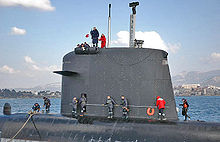 Sail of the French nuclear submarine Casabianca; note the diving planes, camouflaged masts, periscope, electronic warfare masts, door and windows.
Sail of the French nuclear submarine Casabianca; note the diving planes, camouflaged masts, periscope, electronic warfare masts, door and windows.
The hydrostatic effect of variable ballast tanks is not the only way to control the submarine underwater. Hydrodynamic maneuvering is done by several surfaces, which can be moved to create hydrodynamic forces when a submarine moves at sufficient speed. The stern planes, located near the propeller and normally horizontal, serve the same purpose as the trim tanks, controlling the trim, and are commonly used, while other control surfaces may not be present on many submarines. The fairwater planes on the sail and/or bow planes on the main body, both also horizontal, are closer to the centre of gravity, and are used to control depth with less effect on the trim.[48]
When a submarine performs an emergency surfacing, all depth and trim methods are used simultaneously, together with propelling the boat upwards. Such surfacing is very quick, so the sub may even partially jump out of the water, potentially damaging submarine systems.
Submarine hull
Main article: Submarine hullOverview
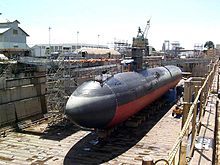 The US Navy Los Angeles-class attack submarine USS Greeneville in dry dock, showing typical cigar-shaped hull.
The US Navy Los Angeles-class attack submarine USS Greeneville in dry dock, showing typical cigar-shaped hull.
Modern submarines are cigar-shaped. This design, visible in early submarines (see below) is sometimes called a "teardrop hull". It reduces the hydrodynamic drag when submerged, but decreases the sea-keeping capabilities and increases drag while surfaced. Since the limitations of the propulsion systems of early submarines forced them to operate surfaced most of the time, their hull designs were a compromise. Because of the slow submerged speeds of those subs, usually well below 10 kt (18 km/h), the increased drag for underwater travel was acceptable. Late in World War II, when technology allowed faster and longer submerged operation and increased aircraft surveillance forced submarines to stay submerged, hull designs became teardrop shaped again to reduce drag and noise. On modern military submarines the outer hull is covered with a layer of sound-absorbing rubber, or anechoic plating, to reduce detection.
The occupied pressure hulls of deep diving submarines such as DSV Alvin are spherical instead of cylindrical. This allows a more even distribution of stress at the great depth. A titanium frame is usually affixed to the pressure hull, providing attachment for ballast and trim systems, scientific instrumentation, battery packs, syntactic flotation foam, and lighting.
A raised tower on top of a submarine accommodates the periscope and electronics masts, which can include radio, radar, electronic warfare, and other systems including the snorkel mast. In many early classes of submarines (see history), the control room, or "conn", was located inside this tower, which was known as the "conning tower". Since then, the conn has been located within the hull of the submarine, and the tower is now called the "sail". The conn is distinct from the "bridge", a small open platform in the top of the sail, used for observation during surface operation.
"Bathtubs" are related to conning towers but are used on smaller submarines. The bathtub is a metal cylinder surrounding the hatch that prevents waves from breaking directly into the cabin. It is needed because surfaced submarines have limited freeboard, that is, they lie low in the water. Bathtubs help prevent swamping the vessel.
Single/double hull
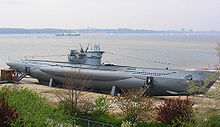 U-995, Type VIIC/41 U-Boat of WWII, showing the typical combination of ship-like non-watertight outer hull with bulky strong hull below
U-995, Type VIIC/41 U-Boat of WWII, showing the typical combination of ship-like non-watertight outer hull with bulky strong hull below
Modern submarines and submersibles, as well as the oldest ones, usually have a single hull. Large submarines generally have an additional hull or hull sections outside. This external hull, which actually forms the shape of submarine, is called the outer hull (casing in the Royal Navy) or light hull, as it does not have to withstand a pressure difference. Inside the outer hull there is a strong hull, or pressure hull, which withstands sea pressure and has normal atmospheric pressure inside.
As early as World War I, it was realized that the optimal shape for withstanding pressure conflicted with the optimal shape for seakeeping and minimal drag, and construction difficulties further complicated the problem. This was solved either by a compromise shape, or by using two hulls; internal for holding pressure, and external for optimal shape. Until the end of World War II, most submarines had an additional partial cover on the top, bow and stern, built of thinner metal, which was flooded when submerged. Germany went further with the Type XXI, a general predecessor of modern submarines, in which the pressure hull was fully enclosed inside the light hull, but optimized for submerged navigation, unlike earlier designs that were optimized for surface operation.
After World War II, approaches split. The Soviet Union changed its designs, basing them on German developments. All post–World War II heavy Soviet and Russian submarines are built with a double hull structure. American and most other Western submarines switched to a primarily single-hull approach. They still have light hull sections in the bow and stern, which house main ballast tanks and provide a hydrodynamically optimized shape, but the main cylindrical hull section has only a single plating layer. The double hulls are being considered for future submarines in the United States to improve payload capacity, stealth and range.[49]
Pressure hull
The pressure hull is generally constructed of thick high strength steel with a complex structure and high strength reserve, and is separated with watertight bulkheads into several compartments. There are also examples of more than two hulls in a submarine, like the Typhoon class, which has two main pressure hulls and three smaller ones for control room, torpedoes and steering gear, with the missile launch system between the main hulls.
The dive depth cannot be increased easily. Simply making the hull thicker increases the weight and requires reduction of onboard equipment weight, ultimately resulting in a bathyscaphe. This is acceptable for civilian research submersibles, but not military submarines.
WWI submarines had hulls of carbon steel, with a 100-metre (330 ft) maximum depth. During WWII, high-strength alloyed steel was introduced, allowing 200-metre (660 ft) depths. High-strength alloy steel remains the primary material for submarines today, with 250–400-metre (820–1,300 ft) depths, which cannot be exceeded on a military submarine without design compromises. To exceed that limit, a few submarines were built with titanium hulls. Titanium can be stronger than steel, lighter, and is not ferromagnetic, important for stealth. Titanium submarines were built by the Soviet Union, which developed specialized high-strength alloys. It has produced several types of titanium submarines. Titanium alloys allow a major increase in depth, but other systems need to be redesigned to cope, so test depth was limited to 1,000 metres (3,300 ft) for the Soviet submarine Komsomolets, the deepest-diving combat submarine. An Alfa-class submarine may have successfully operated at 1,300 metres (4,300 ft),[50] though continuous operation at such depths would produce excessive stress on many submarine systems. Titanium does not flex as readily as steel, and may become brittle during many dive cycles. Despite its benefits, the high cost of titanium construction led to the abandonment of titanium submarine construction as the Cold War ended. Deep diving civilian submarines have used thick acrylic pressure hulls.
The deepest Deep Submergence Vehicle (DSV) to date is Trieste. On October 5, 1959 Trieste departed San Diego for Guam aboard the freighter Santa Maria to participate in Project Nekton, a series of very deep dives in the Mariana Trench. On January 23, 1960, Trieste reached the ocean floor in the Challenger Deep (the deepest southern part of the Mariana Trench), carrying Jacques Piccard (son of Auguste) and Lieutenant Don Walsh, USN.[51] This was the first time a vessel, manned or unmanned, had reached the deepest point in the Earth's oceans. The onboard systems indicated a depth of 11,521 metres (37,799 ft), although this was later revised to 10,916 metres (35,814 ft) and more accurate measurements made in 1995 have found the Challenger Deep to be slightly shallower, at 10,911 metres (35,797 ft).
Building a pressure hull is difficult, as it must withstand pressures at its required diving depth. When the hull is perfectly round in cross-section, the pressure is evenly distributed, and causes only hull compression. If the shape is not perfect, the hull is bent, with several points heavily strained. Inevitable minor deviations are resisted by stiffener rings, but even a one inch (25 mm) deviation from roundness results in over 30 percent decrease of maximal hydrostatic load and consequently dive depth.[52] The hull must therefore be constructed with high precision. All hull parts must be welded without defects, and all joints are checked multiple times with different methods, contributing to the high cost of modern submarines. (For example, each Virginia-class attack submarine costs US$2.6 billion, over US$200,000 per ton of displacement.)
Propulsion
Originally, submarines were human propelled. The first mechanically driven submarine was the 1863 French Plongeur, which used compressed air for propulsion. Anaerobic propulsion was first employed by the Spanish Ictineo II in 1864, which used a solution of zinc, manganese dioxide, and potassium chlorate to generate sufficient heat to power a steam engine, while also providing oxygen for the crew. A similar system was not employed again until 1940 when the German Navy tested a hydrogen peroxide-based system, the Walter turbine, on the experimental V-80 submarine and later on the naval type XVII submarines.[53]
Until the advent of nuclear marine propulsion, most 20th century submarines used batteries for running underwater and gasoline (petrol) or diesel engines on the surface, and for battery recharging. Early submarines used gasoline, but this quickly gave way to kerosene (paraffin), then diesel, because of reduced flammability. Diesel-electric became the standard means of propulsion. The diesel or gasoline engine and the electric motor, separated by clutches, were initially on the same shaft driving the propeller. This allowed the engine to drive the electric motor as a generator to recharge the batteries and also propel the submarine. The clutch between the motor and the engine would be disengaged when the submarine dived, so that the motor could drive the propeller. The motor could have multiple armatures on the shaft, which could be electrically coupled in series for slow speed and in parallel for high speed. (These connections were called "group down" and "group up", respectively.)
Electric transmission
Diesel-electric
Early submarines used a direct mechanical connection between the engine and propeller, switching between diesel engines for surface running, and electric motors for submerged propulsion.
In 1928 the United States Navy's Bureau of Engineering proposed a diesel-electric transmission; instead of driving the propeller directly while running on the surface, the submarine's diesel would drive a generator which could either charge the submarine's batteries or drive the electric motor. This meant that motor speed was independent of the diesel engine's speed, and the diesel could run at an optimum and non-critical speed, while one or more of the diesel engines could be shut down for maintenance while the submarine continued to run using battery power. The concept was pioneered in 1929 in the S-class submarines S-3, S-6, and S-7 to test the concept. No other navy adopted the system before 1945, apart from the Royal Navy's U-class submarines, though some submarines of the Imperial Japanese Navy used separate diesel generators for low speed running.[54]
Other advantages of such an arrangement were that a submarine could travel slowly with the engines at full power to recharge the batteries quickly, reducing time on the surface or on snorkel. It was then possible to insulate the noisy diesel engines from the pressure hull, making the submarine quieter. Additionally, diesel-electric transmissions were more compact.
 German Type XXI submarines, also known as "Elektroboote", were the first submarines designed to operate submerged for extended periods
German Type XXI submarines, also known as "Elektroboote", were the first submarines designed to operate submerged for extended periods
Air-independent propulsion
Main article: Air-independent propulsionDuring the Second World War, German Type XXI submarines were designed to carry hydrogen peroxide for long-term, fast air-independent propulsion, but were ultimately built with very large batteries instead. At the end of the War, the British and Russians experimented with hydrogen peroxide/kerosene (paraffin) engines which could be used surfaced and submerged. The results were not encouraging; although the Russians deployed a class of submarines with this engine type (codenamed Quebec by NATO), they were considered unsuccessful.
Today several navies use air-independent propulsion. Notably Sweden uses Stirling technology on the Gotland-class and Södermanland-class submarines. The Stirling engine is heated by burning diesel fuel with liquid oxygen from cryogenic tanks. A newer development in air-independent propulsion is hydrogen fuel cells, first used on the German Type 212 submarine, with nine 34 kW or two 120 kW cells and soon to be used in the new Spanish S-80 class submarines.[55]
Nuclear power
Main article: Nuclear submarineSteam power was resurrected in the 1950s with a nuclear-powered steam turbine driving a generator. By eliminating the need for atmospheric oxygen, the length of time that a modern submarine could remain submerged was limited only by its food stores, as breathing air was recycled and fresh water distilled from seawater. Nuclear-powered submarines have a relatively small battery and diesel engine/generator powerplant for emergency use if the reactors must be shut down.
Nuclear power is now used in all large submarines, but due to the high cost and large size of nuclear reactors, smaller submarines still use diesel-electric propulsion. The ratio of larger to smaller submarines depends on strategic needs. The US Navy, French Navy, and the British Royal Navy operate only nuclear submarines,[57][58] which is explained by the need for distant operations. Other major operators rely on a mix of nuclear submarines for strategic purposes and diesel-electric submarines for defence. Most fleets have no nuclear submarines, due to the limited availability of nuclear power and submarine technology.
Diesel-electric submarines have a stealth advantage over their nuclear counterparts. Nuclear submarines generate noise from coolant pumps and turbo-machinery needed to operate the reactor, even at low power levels.[59] Some nuclear submarines such as the American Ohio class can operate with their reactor coolant pumps secured, making them quieter than electric subs. A conventional submarine operating on batteries is almost completely silent, the only noise coming from the shaft bearings, propeller, and flow noise around the hull, all of which stops when the sub hovers in mid water to listen, leaving only the noise from crew activity. Commercial submarines usually rely only on batteries, since they never operate independently of a mother ship.
Several serious nuclear and radiation accidents have involved nuclear submarine mishaps.[60][61] The Soviet submarine K-19 reactor accident in 1961 resulted in 8 deaths and more than 30 other people were over-exposed to radiation.[62] The Soviet submarine K-27 reactor accident in 1968 resulted in 9 fatalities and 83 other injuries.[60] The Soviet submarine K-431 accident in 1985 resulted in 10 fatalities and 49 other people suffered radiation injuries.[61]
Alternative propulsion
Oil-fired steam turbines powered the British K-class submarines, built during the first World War and later, to give them the surface speed to keep up with the battle fleet. The K-class subs were not very successful, however.
Toward the end of the 20th century, some submarines, such as the British Vanguard class, began to be fitted with pump-jet propulsors instead of propellers. Although these are heavier, more expensive, and less efficient than a propeller, they are significantly quieter, giving an important tactical advantage.
Magnetohydrodynamic drive (MHD) was portrayed as the operating principle behind the titular submarine's nearly silent propulsion system in the film adaptation of The Hunt for Red October. However, in the novel, the Red October did not use MHD. Although experimental surface ships have used this system, speeds have been below expectations.[citation needed] In addition, the drive system can induce bubble formation, compromising stealth, and the low efficiency requires high powered reactors. These factors make it unlikely for military usage.[citation needed]
Armament
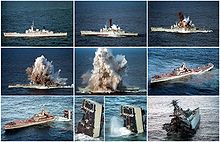 A sequence of photos showing the decommissioned Australian warship HMAS Torrens sinking after being used as a target for a submarine-launched torpedo.
A sequence of photos showing the decommissioned Australian warship HMAS Torrens sinking after being used as a target for a submarine-launched torpedo.
The success of the submarine is inextricably linked to the development of the torpedo, invented by Robert Whitehead in 1866. His invention is essentially the same now as it was 140 years ago. Only with self propelled torpedoes could the submarine make the leap from novelty to a weapon of war. Until the perfection of the guided torpedo, multiple "straight-running" torpedoes were required to attack a target. With at most 20 to 25 torpedoes stored onboard, the number of attacks was limited. To increase combat endurance most World War I submarines functioned as submersible gunboats, using their deck guns against unarmed targets, and diving to escape and engage enemy warships. The importance of guns encouraged the development of the unsuccessful Submarine Cruiser such as the French Surcouf and the Royal Navy's X1 and M-class submarines. With the arrival of ASW aircraft, guns became more for defense than attack. A more practical method of increasing combat endurance was the external torpedo tube, loaded only in port.
The ability of submarines to approach enemy harbours covertly led to their use as minelayers. Minelaying submarines of World War I and World War II were specially built for that purpose. Modern submarine-laid mines, such as the British Mark 6 Sea Urchin, are designed to be deployed by a submarine's torpedo tubes.
After World War II, both the US and the USSR experimented with submarine launched cruise missiles such as the SSM-N-8 Regulus and P-5 Pyatyorka. Such missiles required the submarine to surface to fire its missiles. They were the forerunners of modern submarine launched cruise missiles, which can be fired from the torpedo tubes of submerged submarines, for example the US BGM-109 Tomahawk and Russian RPK-2 Viyuga and versions of surface to surface anti-ship missiles such as the Exocet and Harpoon, encapsulated for submarine launch. Ballistic missiles can also be fired from a submarine's torpedo tubes, for example missiles such as the anti-submarine SUBROC. With internal volume as limited as ever and the desire to carry heavier warloads, the idea of the external launch tube was revived, usually for encapsulated missiles, with such tubes being placed between the internal pressure and outer streamlined hulls.
The strategic mission of the SSM-N-8 and the P-5 were taken up by submarine-launched ballistic missile beginning with the US Navy's Polaris missile, and subsequently the Poseidon and Trident missiles.
Germany is working on the short-range IDAS (missile) which is launched from a torpedo tube and can be used against ASW helicopters as well as surface ships and coastal targets.
Sensors
A submarine will have a variety of sensors determined by its missions. Modern military submarines rely almost entirely on a suite of passive and active sonars to find their prey. Active sonar relies on an audible "ping" to generate echoes to reveal objects around the submarine. Active systems are rarely used, as doing so reveals the sub's presence. Passive sonar is a set of sensitive hydrophones set into the hull or trailed in a towed array, generally several hundred feet long. The towed array is the mainstay of NATO submarine detection systems, as it reduces the flow noise heard by operators. Hull mounted sonar is employed to back up the towed array, and in confined waters where a towed array could be fouled by obstacles.
Submarines also carry radar equipment for detection of surface ships and aircraft. Sub captains are more likely to use radar detection gear rather than active radar to detect targets, as radar can be detected far beyond its own return range, revealing the submarine. Periscopes are rarely used, except for position fixes and to verify a contact's identity.
Civilian submarines, such as the DSV Alvin or the Russian Mir submersibles, rely on small active sonar sets and viewing ports to navigate. Sunlight does not penetrate below about 300 feet (91 m) underwater, so high intensity lights are used to illuminate the viewing area.
Main article: Submarine navigationThe larger search periscope, and the smaller, less detectable attack periscope on HMS Ocelot
Early submarines had few navigation aids, but modern subs have a variety of navigation systems. Modern military submarines use an inertial guidance system for navigation while submerged, but drift error unavoidably builds up over time. To counter this, the Global Positioning System will occasionally be used to obtain an accurate position. The periscope - a retractable tube with prisms allowing a view to the surface - is only used occasionally in modern submarines, since the range of visibility is short. The Virginia-class submarines and Astute-class submarines have photonics masts rather than hull-penetrating optical periscopes. These masts must still be hoisted above the surface, and employ electronic sensors for visible light, infrared, laser range-finding, and electromagnetic surveillance. One benefit to hoisting the mast above the surface is that while the mast is above the water the entire sub is still below the water and is much harder to detect visibly or by radar.
Communication
Main article: Communication with submarinesMilitary submarines have several systems for communicating with distant command centers or other ships. One is VLF (Very Low Frequency) radio, which can reach a submarine either on the surface or submerged to a fairly shallow depth, usually less than 250 feet (76 m). ELF (Extremely Low Frequency) can reach a submarine at much greater depths, but has a very low bandwidth and are generally used to call a submerged sub to a shallower depth where VLF signals can reach. A submarine also has the option of floating a long, buoyant wire antenna to a shallower depth, allowing VLF transmissions to be made by a deeply submerged boat.
By extending a radio mast, a submarine can also use a "burst transmission" technique. A burst transmission takes only a fraction of a second, minimizing a submarine's risk of detection.
To communicate with other submarines, a system known as Gertrude is used. Gertrude is basically a sonar telephone. Voice communication from one submarine is transmitted by low power speakers into the water, where it is detected by passive sonars on the receiving submarine. The range of this system is probably very short, and using it radiates sound into the water, which can be heard by the enemy.
Civilian submarines can use similar, albeit less powerful systems to communicate with support ships or other submersibles in the area.
Crew
A typical nuclear submarine has a crew of over 80. Non-nuclear boats typically have fewer than half as many. The conditions on a submarine can be difficult because crew members must work in isolation for long periods of time, without family contact. Submarines normally maintain radio silence to avoid detection. Operating a submarine is dangerous, even in peacetime, and many submarines have been lost in accidents.
Women as part of crew
Most navies prohibited women from serving on submarines, even after they had been permitted to serve on surface warships. The Royal Norwegian Navy became the first navy to allow female crew on its submarines in 1985. The Royal Danish Navy allowed female submariners in 1988.[63] Others followed suit including the Swedish Navy (1989),[64] the Royal Australian Navy (1998), the German Navy (2001) and the Canadian Navy (2002). In 1995, Solveig Krey of the Royal Norwegian Navy became the first female officer to assume command on a military submarine, HNoMS Kobben.[65]
The British Royal Navy does not permit women to serve on its submarines because of "medical concerns for the safety of the fetus and hence its mother" due to the potentially compromised air quality onboard submarines.[66] Similar dangers to the pregnant woman and her fetus barred females from submarine service in Sweden 1983, when all other positions were made available for them in the Swedish Navy. Pregnant women are still not allowed to serve on submarines in Sweden. However, the policy makers thought that it was discriminatory with a general ban and demanded that females should be tried on their individual merits and have their suitability evaluated and compared to other candidates. Further, they noted that a female complying with such high demands is unlikely to become pregnant unawares.[64]
Women have served on U.S. Navy surface ships since 1993, and as of 2011-2012[update] will begin serving on submarines for the first time. Until presently, the Navy only allowed three exceptions for women being on board military submarines: female civilian technicians for a few days at most, women midshipmen on an overnight during summer training for both Navy ROTC and Naval Academy, and family members for one-day dependent cruises.[67] In 2009, senior officials, including then-Secretary of the Navy Ray Mabus, Joint Chief of Staff Admiral Michael Mullen, and Chief of Naval Operations Admiral Gary Roughead, began the process of finding a way to implement females onboard submarines.[68] In 2011, the first classes of female submarine officers graduated from Naval Submarine School's Submarine Officer Basic Course (SOBC) at the Naval Submarine Base New London.[69] Additionally, more senior ranking and experienced female supply officers from the surface warfare specialty will attend SOBC as well, and proceed to fleet Ballistic Missile (SSBN) and Guided Missile (SSGN) submarines along with the new female submarine line officers beginning in late 2011/early 2012.[70]
Both the U.S. and British navies operate nuclear-powered submarines which deploy for periods of six months or longer, whereas the other navies that do permit women to serve on submarines operate conventionally powered submarines, which deploy for much shorter periods, usually only for one or two months.[71] Prior the recent change by the U.S., no nation using nuclear submarines permitted women to serve onboard them.[72]
Life support systems
With nuclear power, submarines can remain submerged for months at a time. Diesel submarines must periodically resurface or snorkel to recharge their batteries. Most modern military submarines generate breathing oxygen by electrolysis of water. Atmosphere control equipment includes a CO2 scrubber, which uses an amine absorbent to remove the gas from air and diffuse it into waste pumped overboard. A machine that uses a catalyst to convert carbon monoxide into carbon dioxide (removed by the CO2 scrubber) and bonds hydrogen produced from the ship's storage battery with oxygen in the atmosphere to produce water, is also used. An atmosphere monitoring system samples the air from different areas of the ship for nitrogen, oxygen, hydrogen, R-12 and R-114 refrigerants, carbon dioxide, carbon monoxide, and other gases. Poisonous gases are removed, and oxygen is replenished by use of an oxygen bank located in a main ballast tank. Some heavier submarines have two oxygen bleed stations (forward and aft). The oxygen in the air is sometimes kept a few percent less than atmospheric concentration to reduce fire danger.
Fresh water is produced by either an evaporator or a reverse osmosis unit. The primary use for fresh water is to provide feed water for the reactor and steam propulsion plants. It is also available for showers, sinks, cooking and cleaning once propulsion plant needs have been met. Seawater is used to flush toilets, and the resulting "black water" is stored in a sanitary tank until it is blown overboard using pressurized air or pumped overboard by using a special sanitary pump. The method for blowing sanitaries overboard is difficult to operate, and the German Type VIIC boat U-1206 was lost with casualties because of a mistake with the toilet.[73] Water from showers and sinks is stored separately in "grey water" tanks, which are pumped overboard using the drain pump.
Trash on modern large submarines is usually disposed of using a tube called a Trash Disposal Unit (TDU), where it is compacted into a galvanized steel can. At the bottom of the TDU is a large ball valve. An ice plug is set on top of the ball valve to protect it, the cans atop the ice plug. The top breech door is shut, and the TDU is flooded and equalized with sea pressure, the ball valve is opened and the cans fall out assisted by scrap iron weights in the cans. The TDU is also flushed with seawater to ensure it is completely empty and the ball valve is clear before shutting the valve.
See also
- Autonomous underwater vehicle
- Deep Submergence Rescue Vehicle
- List by death toll of ships sunk by submarines
- List of countries with submarines
- List of submarine actions
- List of submarine museums
- List of sunken nuclear submarines
- Merchant submarine
- Submarines in the United States Navy
- Submarine films
- Submarine simulator, a computer game genre
- Submarine warfare
- Naval Submarine Medical Research Laboratory (United States)
- Category:Fictional submarines
Related topics
- Depth charge
- Timeline of underwater technology
- Modern Naval tactics
- Nuclear navy
- Submarine communications cable
- Submarine power cable
- Submersible
- Semi-submersible
- Submarine Voyage
- Midget submarine
Articles on specific vessels
- List of submarines of the Royal Navy
- List of submarines of the United States Navy
- List of ships of the Soviet Navy#Submarines
- Submarines of the People's Liberation Army Navy (China)
- Submarines of the Indian Navy
- List of U-boats
Articles on specific submarine classes
- List of Soviet and Russian submarine classes
- List of submarine classes
- List of submarine classes of the Royal Navy
- List of United States submarine classes
References
- ^ Inventor of the Week: Archive. mit.edu
- ^ Submarino Hipopótamo: http://www.armada.mil.ec/index.php?option=com_content&task=view&id=44
- ^ Hipopotamo submarine: Scale model at the Museum of Maritime History of the Ecuadorian Navy; http://www.digeim.armada.mil.ec/index.php?option=com_phocagallery&view=category&id=9:submarino-qhipopotamoq&Itemid=12
- ^ Showell p. 23
- ^ a b c d e Chuck Veit (September 17, 2011). "Submarines in the Civil War". On Deck: The webzine of the Navy and Marine Living History Association. http://www.navyandmarine.org/ondeck/1862submarines.htm.
- ^ Chuck Veit "The Innovative Mysterious Alligator" page 26 US Naval Institute NAVAL HISTORY published August 2010 ISSN 1042-1920
- ^ a b "American Diver: A New Diver of Destruction". Friends of the Hunley. September 17, 2011. http://www.hunley.org/main_index.asp?CONTENT=DIVER.
- ^ "First Crew: August 29th, 1863". Friends of the Hunley. September 17, 2011. http://www.hunley.org/main_index.asp?CONTENT=FIRSTCREW.
- ^ "Second Hunley Crew: October 15, 1863". Friends of the Hunley. September 17, 2011. http://www.hunley.org/main_index.asp?CONTENT=SECONDCREW.
- ^ "Lt. George Dixon and the Third Crew". Friends of the Hunley. September 17, 2011. http://www.hunley.org/main_index.asp?CONTENT=THIRDCREW.
- ^ Friends of the Hunley
- ^ H.L. Hunley
- ^ a b John Pike. "Globalsecurity". Globalsecurity. http://www.globalsecurity.org/military/systems/ship/sub-history4.htm. Retrieved 2010-04-18.
- ^ "Submarine Heritage Centre - submarine history of Barrow-in-Furness". Submarineheritage.com. http://www.submarineheritage.com/history.html. Retrieved 2010-04-18.
- ^ Humble, Richard (1981). Underwater warfare. Chartwell Books, p. 174. ISBN 0890094241
- ^ "French Sub Gymnote". battleships-cruisers.co.uk. http://www.battleships-cruisers.co.uk/submarines2.htm. Retrieved 2010-08-22.
- ^ Simmons p. 107
- ^ a b c Jentschura p. 160
- ^ Showell p. 201
- ^ a b Showell p. 29
- ^ Watts p. 18, 21
- ^ U.S. Patent 708,553
- ^ Olender p. 175
- ^ Showell p. 36
- ^ Thomas Adam. Germany and the Americas. p. 1155.
- ^ Gibson and Prendergast, p. 2
- ^ Roger Chickering, Stig Förster, Bernd Greiner, German Historical Institute (Washington, D.C.) (2005). "A world at total war: global conflict and the politics of destruction, 1937-1945". Cambridge University Press. p.73. ISBN 0521834325
- ^ Crocker III, H. W. (2006). Don't Tread on Me. New York: Crown Forum. p. 310. ISBN 9781400053636.
- ^ Blair, p.576.
- ^ Blair, pp.767-768; O'Kane, Clear the Bridge.
- ^ Blair, passim.
- ^ a b c O'Kane, p. 333.
- ^ Blair, Clay, Jr. Silent Victory, pp. 991-2. The others were lost to accidents or, in the case of Seawolf, friendly fire.
- ^ Less the crews of S-26, R-12, and possibly Dorado lost to accident, and Seawolf, to friendly fire. S-36 and Darter, lost to grounding, took no casualties. Blair, passim.
- ^ a b c Blair, p.878.
- ^ "Submarine History". The Royal Navy. http://www.royalnavy.mod.uk/server/show/nav.2558. Retrieved 18 April 2007.[dead link]
- ^ History of USS Nautilus SSN571[dead link]
- ^ Tony Long. "May 10, 1960: USS ''Triton'' Completes First Submerged Circumnavigation". Wired.com. http://www.wired.com/science/discoveries/news/2007/05/dayintech_0510. Retrieved 2010-04-18.
- ^ LYDIA POLGREEN (July 26, 2009). "India Launches Nuclear Submarine". New York Times. http://www.nytimes.com/2009/07/27/world/asia/27india.html?_r=1&scp=1&sq=submarine&st=cse.
- ^ Joe Lynam (2010-05-20). "'North Korean torpedo' sank South's navy ship - report". BBC News. http://news.bbc.co.uk/2/hi/world/asia_pacific/10129703.stm. Retrieved 2010-08-06.
- ^ a b c d e f g h i j k l m n o p McLaren, Alfred S., CAPT USN "Under the Ice in Submarines" United States Naval Institute Proceedings July 1981 pp.105-109
- ^ William J. Broad (March 18, 2008). "Queenfish: A Cold War Tale". New York Times. http://www.nytimes.com/2008/03/18/science/18arctic.html?_r=1. Retrieved 2010-02-17.
- ^ David Bruce Weaver (2001). The Encyclopedia of Ecotourism. CABI. p. 276. ISBN 0851993680.
- ^ Booth, William; Forero, Juan (2009-06-06). "Plying the Pacific, Subs Surface as Key Tool of Drug Cartels". The Washington Post. http://www.washingtonpost.com/wp-dyn/content/article/2009/06/05/AR2009060503718_3.html.
- ^ "Farc's drug submarine seized in Colombia". September 25, 2011. http://www.bbc.co.uk/news/world-latin-america-15051108.
- ^ "Physics Of Liquids & Gases". Elementary Classical Physics. http://www.vectorsite.net/tpecp_08.html. Retrieved 2006-10-07.
- ^ Richard O'Kane (1987). Wahoo. Presidio Press. p. 12.
- ^ Roy Burcher, Louis Rydill (1995). Concepts In Submarine Design. Cambridge University Press. p. 170.
- ^ [1]. National Defense magazine.[dead link]
- ^ "Federation of American Scientists". Fas.org. http://www.fas.org/man/dod-101/sys/ship/deep.htm. Retrieved 2010-04-18.
- ^ "Trieste". History.navy.mil. http://www.history.navy.mil/danfs/t8/trieste.htm. Retrieved 2010-04-18.
- ^ US Naval Academy
- ^ "Details on German U-Boat Types". Sharkhunters International. http://www.sharkhunters.com/typeadditional.htm. Retrieved 2008-09-21.
- ^ Friedman, Norman (1995). [1557502633 U.S. submarines through 1945: an illustrated design history]. Naval Institute Press. pp. 259–260. 1557502633.
- ^ "S-80: A Sub, for Spain, to Sail Out on the Main". Defense Industry Daily. 15-Dec-2008. http://www.defenseindustrydaily.com/s80-a-sub-for-spain-to-sail-out-on-the-main-02517/.
- ^ Milligan, Brian (2007-05-07). "Alien submarine breaks technical barriers". BBC News. http://news.bbc.co.uk/1/hi/business/6625477.stm. Retrieved 2010-04-18.
- ^ "Submarine Warfare". Archived from the original on 2006-10-11. http://web.archive.org/web/20061011113151/http://www.odu.edu/ao/hrnrotc/students/ns_courses/101odu/sumbmarine+presentation+2005.ppt. Retrieved 2006-10-07.
- ^ "France Current Capabilities". Nti.org. http://www.nti.org/db/submarines/france/index.html. Retrieved 2010-04-18.
- ^ Thompson, Roger (2007). Lessons Not Learned. US Naval Institute Press. p. 34. ISBN 9781591148654.
- ^ a b Johnston, Robert (September 23, 2007). "Deadliest radiation accidents and other events causing radiation casualties". Database of Radiological Incidents and Related Events. http://www.johnstonsarchive.net/nuclear/radevents/radevents1.html.
- ^ Strengthening the Safety of Radiation Sources p. 14.
- ^ "NATO Review - Vol.49 - No 2 - Summer 2001: Women in uniform". Nato.int. 2001-08-31. http://www.nato.int/docu/review/2001/0102-09.htm. Retrieved 2010-04-18.
- ^ a b "Historik" (in Swedish). Archived from the original on 1996-01-01. http://web.archive.org/web/19960101-re_/http://www.rekryc.mil.se/article.php?id=11756.
- ^ "Forsvarsnett: Historikk" (in Norwegian). Archived from the original on 1996-01-01. http://web.archive.org/web/19960101-re_/http://www.mil.no/felles/fms/utdanning/start/jenter/historikk/.
- ^ Royal Navy. "More Submarine FAQs". http://www.royalnavy.mod.uk/operations-and-support/submarine-service/submarine-faqs/more-submarine-faqs/.
- ^ question #10[dead link]
- ^ William H. McMichael and Andrew Scutro (September 27, 2009). "SecNav, CNO: Women should serve on subs". Navy Times. http://www.navytimes.com/news/2009/09/navy_roughead_subs_092409w/.
- ^ http://www.ct.gov/oma/cwp/view.asp?a=3422&q=483312
- ^ http://www.navy.mil/search/display.asp?story_id=52990
- ^ "Commander of the Submarine Fleet". http://www.csp.navy.mil/.
- ^ "Navy Seeks to Allow Women to Serve on Submarines". Washingtonpost.com. September 26, 2009. http://www.washingtonpost.com/wp-dyn/content/article/2009/09/25/AR2009092503385.html?hpid=moreheadlines. Retrieved 2010-04-18.
- ^ "U-1206". Uboat.net. http://www.uboat.net/boats/u1206.htm. Retrieved 2010-04-18.
Bibliography
- General history
- Histoire des sous-marins: des origines à nos jours by Jean-Marie Mathey and Alexandre Sheldon-Duplaix. (Boulogne-Billancourt: ETAI, 2002).
- Culture
- Redford, Duncan. The Submarine: A Cultural History From the Great War to Nuclear Combat (I.B. Tauris, 2010) 322 pages; focus on British naval and civilian understandings of submarine warfare, including novels and film.
- Submarines before 1914
- Gardiner, Robert (1992). Steam, Steel and Shellfire, The steam warship 1815-1905. Annapolis, Maryland: Naval Institute Press. ISBN 9781557507747. OCLC 30038068.
1900/Russo-Japanese War 1904-1905
- Jentschura, Hansgeorg; Dieter Jung, Peter Mickel (1977). Warships of the Imperial Japanese Navy 1869-1945. Annapolis, Maryland: United State Naval Institute. ISBN 0-87021-893-X.
- Olender, Piotr (2010). Russo-Japanese Naval War 1904-1905 Vol. 2 Battle of Tsushima. Sandomierz 1, Poland: Stratus s.c.. ISBN 978-83-61421-02-3.
- Showell, Jak (2006). The U-Boat Century-German Submarine Warfare 1906-2006. Great Britain: Chatham Publishing. ISBN 1-86176241-0.
- Simmons, Jacques (1971). A Grosset All-Color Guide WARSHIPS. United States: Grosset & Dunlap, Inc.. ISBN 0-448-04165-0.
- Watts, Anthony J. (1990). The Imperial Russian Navy. London: Arms and Armour Press. ISBN 0-85368-912-1.
- World War II
- Blair, Clay (1975). Silent Victory: The U.S. Submarine War Against Japan. Philadelphia: Lippincott. ISBN 9780397007530. OCLC 821363.
- Lockwood, Charles A. (1951). Sink 'Em All: Submarine Warfare in the Pacific. New York: Dutton. OCLC 1371626.
- O'Kane, Richard H. (1977). Clear the Bridge!: The War Patrols of the USS Tang. Chicago: Rand McNally. ISBN 9780528810589. OCLC 2965421.
- O'Kane, Richard H. (1987). Wahoo: The Patrols of America's Most Famous World War II Submarine. Novato, California: Presidio Press. ISBN 9780891413011. OCLC 15366413.
- Werner, Herbert A. (1999). Iron coffins: a personal account of the German U-Boat battles of World War II. London: Cassell Military. ISBN 9780304353309. OCLC 41466905.
- Cold War
- Hide and seek: the untold story of Cold War espionage at sea, by Peter Huchthausen and Alexandre Sheldon-Duplaix. (Hoboken, NJ: J. Wiley & Sons, 2008).
External links
Listen to this article (info/dl)
This audio file was created from a revision of Submarine dated 2006-01-11, and does not reflect subsequent edits to the article. (Audio help)More spoken articles- U.S. Patent 708,553 - Submarine boat
- Submariners Association - UK Submariners site and Boat Database
- German Submarines of WWII and U-boat losses in 1943
- Role of the Modern Submarine
- U.S. World War II Submarine Veterans History Project
- Record breaking Japanese Submarines
- German U-Boats 1935–1945 (German)
- U.S. submarine photo archive
- The Invention of the Submarine
- List of active Naval Submarines
- The Fleet Type Submarine Online US Navy submarine training manuals, 1944-1946.
- The Home Front: Manitowoc County in World War II: Video footage of submarine launches into Lake Michigan during World War II.
- American Society of Safety Engineers. Journal of Professional Safety. Submarine Accidents: A 60-Year Statistical Assessment. C. Tingle. Sept. 2009. Pages 31–39. Ordering full article: https://www.asse.org/professionalsafety/indexes/2009.php; or Reproduction less graphics/tables: http://www.allbusiness.com/government/government-bodies-offices-government/12939133-1.html.
Categories:- Submarines
- 1620 introductions
- Electric vehicles
- Pressure vessels
- Ship types
Wikimedia Foundation. 2010.

